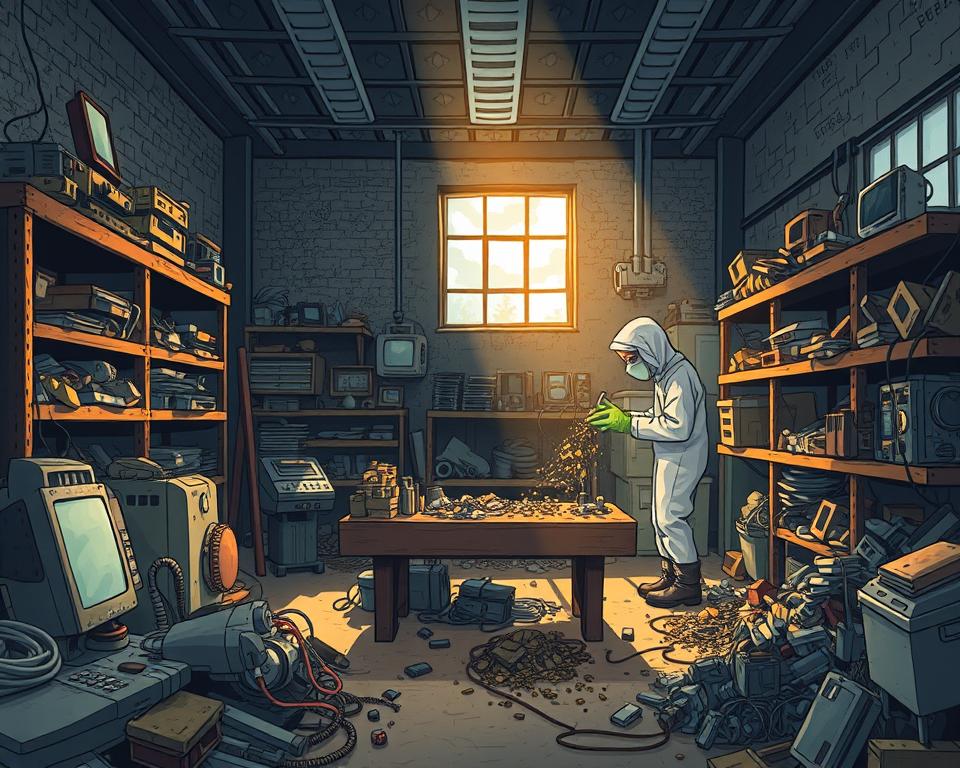Your Sustainable Precious Metal Recycling Guide
Did you know that more than $60 billion worth of precious metals are discarded each year in electronic waste alone? Such a massive amount highlights why precious metal recycling is so vital. It’s not just good for our economy but also for the environment. By recycling metals like gold, silver, platinum, and palladium, we cut down on pollution and save natural resources.
Leaders such as Dongsheng Metal Trading are paving the way for sustainable recycling. They make sure those precious metals get reused rather than landfilled. This precious metals recycling approach is key to eco-friendly recycling and sustainable practices.
Critical Points
- More than $60 billion of precious metals end up in e-waste each year.
- Precious metal recycling reduces environmental impact and conserves resources.
- Gold, silver, platinum, and palladium top the list of valuable metals.
- Sustainable development depends on eco-friendly recycling.
- Firms such as Dongsheng Metal Trading focus on precious metal recovery.
What Makes Precious Metals So Valuable
Precious metals are rare, naturally occurring metallic elements that have captured the interest of investors and industries alike. Gold, silver, platinum, and palladium stand out for their distinct qualities. These include electrical conductivity, corrosion resistance, and substantial rarity. Extracting and refining them uses up huge resources, so recycling becomes critical.

Intrinsic qualities and demand in the marketplace determine precious metals’ worth. Metal recycling ensures the supply chain remains robust. It cuts the environmental toll of mining operations. Advanced recycling can bring metals back to their initial quality. This preserves finite resources while yielding economic benefits.
Defining Precious Metals
Precious metals possess unique characteristics that make them desirable for a variety of applications. Economic value stems from their scarcity and innate qualities. For example:
- Au: Prized for its shine and tarnish-proof nature.
- Ag: Recognized for its versatility and high conductivity.
- Pt: Celebrated for its durability and catalytic properties.
- Pd: On the rise in automotive and tech industries.
Benefits of Precious Metal Recycling
Recovering precious metals plays a crucial role in sustainability. It saves scarce materials and sharply cuts mining’s eco-footprint. Consider these advantages:
- Lessening of habitat destruction from mining.
- Using far less energy than fresh extraction.
- Supporting a circular economy via material reuse.
- Economic upside from extracting high-value resources.
Impact of Recycling Precious Metals
Metal recycling brings both green and economic gains. Pointing out these perks shows how to shrink our eco-impact. It also drives economic growth and stability.
Environmental Benefits
The environmental benefits of recycling precious metals are significant. Retrieving metals from scrap and electronics reduces landfill load. It curbs mining demand and preserves nature.
It curtails mining’s damage, like habitat loss and toxins. A focus on metal recovery moves us toward real sustainability.
Financial Gains
The economic benefits of recycling are equally compelling. Recovering metals cuts production expenses. This allows industries to use reclaimed metals instead of new ones.
It produces recycling-sector employment and strengthens markets with growing recycled-metal needs. Harnessing these gains helps firms improve their bottom line. They also contribute to a greener economy.
Steps in Metal Recycling
The precious metal recycling process is complex, involving several stages to ensure maximum efficiency. It starts with collecting metals from various sources like discarded electronics, jewelry, and industrial scraps. Next comes sorting, cleaning, and testing to assess metal content and worth.
Recycling Workflow
This systematic approach is vital for effective metal recovery. Each step is designed to optimize the yield of precious metals. Sorting divides metals by kind and grade. Cleaning strips away impurities that impede extraction. Analysis identifies the concentration of precious metals, guiding the choice of recycling techniques.
Metal Separation Techniques
High-tech methods are used to maximize metal retrieval. One method, thermal reduction, leverages heat to separate metals from base materials. Melting refines and aggregates metals, while wet chemical processes are used for delicate separations. Firms such as Dongsheng Metal Trading apply these techniques to raise recovery and profits.
Recyclable Precious Metals
Scrap recovery benefits both Earth and economy. Many precious metals can be recycled, benefiting both the economy and the planet. It’s important for people and businesses to know which metals can be recycled.
Gold, Silver, and Platinum
Familiar precious metals include gold, silver, and platinum. They’re found in jewelry, coins, and industrial uses. Gold recovery is widespread because of its worth and need. Silver’s role in cameras, electronics, and solar energy makes its recycling vital.
Platinum, though less common, is valuable, mainly in catalytic converters.
E-Waste Metals
Electronics scrap contains metals ripe for recovery. Devices such as phones and computers hold palladium and indium. These metals are a treasure trove for recycling, reducing e-waste and providing essential materials.
The need to recycle these metals is critical. Businesses work to reduce scrap and upscale resource recovery.
Industry Benefits of Precious Metal Recovery
Precious metal recycling is essential for several key industries, allowing them to use valuable resources efficiently and sustainably. Device manufacturing in electronics profits hugely from recovered metals. The aerospace and medical fields use precious metals in essential applications. Examining industry recovery uncovers eco- and economic advantages.
E-Waste Sector
Because devices abound with metals, electronics tops recycling efforts. Quick device turnover spawns more electronic scrap. This makes effective recycling of these metals, such as gold, silver, and palladium, critical. It not only conserves natural resources but also reduces mining-related carbon emissions.
Firms ramp up recycling to hit sustainability targets. This shift supports the ongoing need for resource conservation and environmental protection.
High-Tech Industries
Metal recovery is key in aerospace and medical sectors where metals are in vital parts. High-performance alloys are essential for manufacturing flight parts and medical devices due to their durability and resistance to corrosion. Recycling these metals can significantly lower material costs and comply with environmental regulations.
Both industries understand that responsible recycling practices help mitigate resource scarcity. It also enhances operational efficiency, making recycling a key strategy for sustainability.
How to Choose a Metal Recycler
Finding trustworthy precious metal recycling companies is key to recycling effectively. You should probe their procedures thoroughly. Their fees and techniques will shape your outcome. Service comparisons help you pick the best recycler.
Questions to Ask Recycling Companies
- Can you share your precious-metal recovery accreditations?
- Can you explain your processing methods for different metals?
- Which recovery percentages do you achieve for each metal?
- How do you handle pricing, and what additional fees might apply?
- Do you have client testimonials or references?
Service & Price Comparison
You must evaluate services side-by-side to pick the right recycler. Use a table to line up these factors:
| Company Name | Recovery Rate (%) | Processing Fee ($) | Turnaround Time (Days) |
|---|---|---|---|
| Recycling Co. A | 95 | 50 | 7 |
| Recycling Co. B | 90 | 45 | 5 |
| Recycling Co. C | 92 | 55 | 10 |
By comparing recycling services, you can find the best recycler for your needs. That way, you maximize returns and maintain quality.
Precious Metal Recycling: Your Eco-Friendly Guide
Understanding how recyclers operate is key for those interested in precious metal recycling. They handle all stages, from gathering to final refining. This ensures maximum efficiency and value from metals.
How Recyclers Operate
Advanced workflows—assay, separation, smelting—unlock metal value. They start by collecting metal scraps from various sources. Next, they employ precise methods to sort metals. Finally, they refine each batch to recover gold, silver, platinum, etc.
This process not only maximizes resource recovery but also supports eco-friendly practices. It’s essential for long-term sustainability.
Finding Your Perfect Recycling Partner
When picking a recycler, several factors are important. First, look at their environmental practices. Now more than ever, green commitment is crucial. Also, consider the services they offer, from basic collection to full processing.
Your budget will influence your choice. Gather price quotes for side-by-side comparisons. Companies like Dongsheng Metal Trading offer customized solutions for various industries. They stand out as dependable recyclers.
Types of Recycling Facilities
Recovery facilities are central to green waste solutions. Multiple types of facilities handle various recycling demands. Understanding these facilities improves access to recyclers and their services. This benefits both businesses and the environment.
Recycling Center Types
Metal recycling facilities vary widely in their operations. Some focus on precious metals, while others handle a wide range of materials. Common examples include:
- General scrap yards handle both ferrous and non-ferrous materials.
- Specialized firms recover gold, silver, and platinum with advanced refining.
- Electronics recyclers extract metals from old gadgets.
Choosing Facility Locations
Easy access to facilities boosts recovery efficiency. Firms need to plan transport logistics. Here are some factors that influence access:
| Factor | Description |
|---|---|
| Distance | Closer sites cut shipping costs and delays. |
| Networking | Strong ties with local centers streamline recovery. |
| Services Offered | Awareness of service menus aids in picking the right center. |
In sum, selecting the right type of recycling center and ensuring convenient access can significantly enhance the efficiency of metal recycling operations.
Electronic Waste Recycling and Precious Metals
Discarded electronics threaten the environment. Discarded devices often contain precious metals that can be recovered through recycling. This highlights the importance of seeing e-waste as a valuable resource.
Electronic Precious Metals
Gadgets harbor small quantities of precious metals. You’ll find them in components such as:
- Circuit boards
- Connectors and ports
- Capacitors and resistors
- Battery terminals
Common electronics conceal recoverable metals. Recycling lets us reclaim and repurpose those metals.
Why Recycle E-Waste?
Recovering e-waste metals safeguards the environment and reclaims materials. It trims dump loads and conserves raw materials. Key perks include:
- It minimizes environmental risks from improper disposal
- It reduces CO₂ output via green recycling methods
- It bolsters circular models by returning scrap to production
Promoting e-waste recovery advances resource stewardship. It lays the groundwork for a greener future.
Future Trends in Metal Recovery
Recycling is changing fast thanks to new tech and eco-driven demand. Facing resource limits, recyclers embrace new methods. By integrating novel processes, they pave the way forward.
Trends in Sustainable Recycling
Modern green recycling strives to cut waste and eco-damage. Firms now use bio-packaging and low-energy methods. Such moves match worldwide green goals and nudge industries to be more eco-responsible.
New Metal Recovery Tech
New methods in recovery enhance recycling performance. Robotic sorting and chemical extraction raise recovery. These innovations not only increase resource extraction but also reduce environmental impact, marking a significant step forward in recycling precious metals.
Starting a Precious Metal Recycling Venture
Building a metal recycling enterprise calls for thorough planning and industry knowledge. Founders need a roadmap, regulatory know-how, and solid groundwork. Key tasks include market studies and pinpointing customer segments. Permits and regulatory clarity underpin ongoing success.
Steps to Establishing a Business
Setting up a precious metal recycling venture requires several essential steps:
- Analyze market demand and competitor landscape.
- Develop a detailed business plan outlining goals and strategies.
- Invest in equipment tailored to your process needs.
- Secure funding through loans or investments.
- Secure regulatory approvals and certifications.
- Deploy promotional plans to gain customers.
Legal Considerations and Certifications
Understanding legal aspects when starting a precious metal recycling business is critical. Adherence to environmental regulations ensures your operation is safe and sustainable. Key considerations include:
- Securing business certification from relevant authorities.
- Complying with local, state, and federal regulations on waste disposal and recycling.
- Ensuring all employees are trained on safety protocols and procedures.
Conclusion
Precious metal recycling is essential for preserving natural resources and improving environmental health. It allows individuals and businesses to lessen waste’s impact on our planet. The recovered metals reduce mining needs and boost the economy by creating jobs in recycling.
Metal recovery delivers both eco and economic upsides. Working with Dongsheng Metal Trading guarantees green standards. Such alliances reinforce the circular economy for all stakeholders.
The journey to a sustainable future depends on collective action in recycling precious metals. Increased awareness builds a culture of green consumption and care. Implementing these measures supports us today and safeguards future generations.


